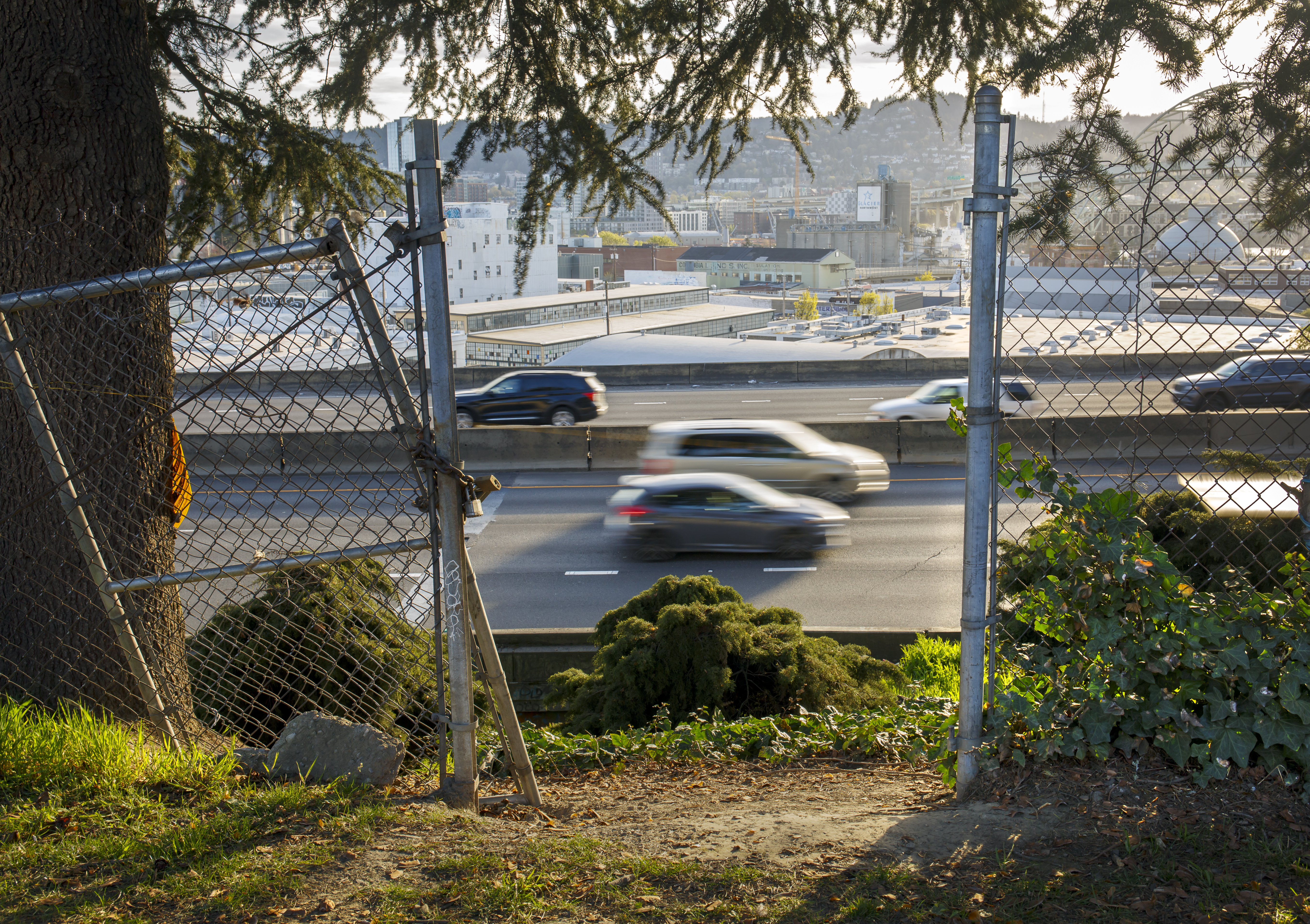
The I-5 freeway is seen through the fencing at the back of Harriet Tubman Middle School in North Portland, April 9, 2021. Gov. Kate Brown supports moving the school.
Kristyna Wentz-Graff / OPB
Oregon Gov. Kate Brown now says she supports moving forward with a plan that would expand Interstate 5 through Portland’s Rose Quarter while spending more than $1 billion to build a robust “cap” over the freeway to rebuild a community torn apart by its initial construction.
Speaking before a meeting of stakeholder and advisory groups convened by the Oregon Department of Transportation, Brown also confirmed on Tuesday she hoped to relocate a middle school perched on the highway’s fringes. Such a move could grant additional space for the expansion process, and address concerns about poor air quality impacting students.
“Over the past few weeks I’ve hosted conversations with some key government and community stakeholders,” Brown said in a brief appearance before the committees. “I began those conversations because I wanted to ensure that this project is part of addressing and not repeating the historic wrongs caused by the displacement of countless Black families, and the resulting generational damage that occurred. And I also did it because I truly believe that there was a win-win opportunity ... .”
The plan Brown landed on, known as “hybrid 3” is an attempt to address the many competing priorities different groups have brought to the controversial highway expansion project.
Business leaders and state transportation officials have said for years that an existing bottleneck on the highway creates harmful delays and poses a risk for crashes that repeatedly snarl traffic. Members of Portland’s Black community have forcefully argued any project needs to include a strong highway cap that will allow for development in a historically African American neighborhood destroyed by the construction of I-5. And climate and transportation activists say the entire premise of increasing highway throughput is wrongheaded at a time when the impacts of climate change are being felt more acutely than ever.
While the precise details of the approach must still be hammered out, a summary of the “hybrid 3” approach includes calls for a highway cover estimated to cost between $1.1 billion and $1.16 billion — the vast majority of the project’s total cost. Those caps could accommodate three-story buildings, ODOT says. Previous iterations of the highway project had included two unconnected covers, with limited opportunity for building.
The new proposal also calls for more narrow inside shoulders on I-5, and a number of other alterations to surface street traffic patterns from past proposals. In all, the changes could delay the project for a year, ODOT says. The agency’s overview of the plan suggests construction could begin in late 2023.
Brown told committee members on Tuesday that the project represented a “historic opportunity” to access federal funds “for a Rose Quarter project that can serve as a national model for restorative justice, sustainable transportation, and of course job creation.” She added: “I absolutely believe hybrid 3 represents the compromise we’ve all been looking for.”
The ultimate decisions, she suggested, would be led by Portland community members and the city.
Brown also confirmed on Tuesday she’d been in talks about moving Harriet Tubman Middle School, whose proximity to the interstate has been held up by opponents as a reason the expansion project should not move forward. Last week, Portland school board members approved a resolution calling on the state to pay to build a new middle school.
Brown said she “strongly” supports moving the school “to protect the exposure of our students to poor air quality.” Willamette Week first reported the governor’s support of that idea.
Exactly how Brown’s newly announced support will play with interested parties is unclear. In a meeting following Brown’s remarks, some committee members voiced concerns about the potential tradeoffs of the approach, and other community leaders have repeatedly raised concerns about the state’s process.
“It sounds like we’ve made a decision to go with hybrid 3,” said Joe McFerrin, a member of the Community Oversight Advisory Committee convened by ODOT to provide input on the project. “I just want a sense of where we are with the decision-making process.”
Others were less cautious, embracing Brown’s involvement as a watershed development that could help talks proceed.
“It’s like splitting the baby,” said James Posey, another COAC member. “It’s a good thing to see people really put aside some of their individual interests and come together.”


